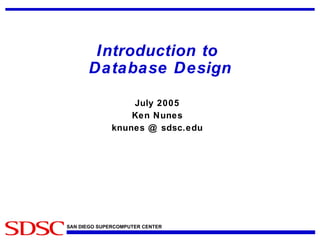
Nunes database
- 1. Introduction to Database Design July 2005 Ken Nunes knunes @ sdsc.edu
- 12. Connectivity Department Manager has 1 1 Department Project has N 1 Employee Project works on N M one-to-one one-to-many many-to-many
- 17. Team ER Diagram Players Games Sales play generates N 1 1 1 Start date End date Statistics Name tickets merchandise opponent date result
- 19. Entity tables Transform each entity into a table with a key and its attributes. Name SSN Employee create table employee (emp_no number, name varchar2(256), ssn number, primary key (emp_no));
- 21. Foreign Key Department Employee Accounting has 1 employee: Brian Burnett Human Resources has 2 employees: Nora Edwards Ben Smith IT has 3 employees: Ajay Patel John O’Leary Julia Lenin
- 23. Many-to-Many tables Project Employee proj_has_emp Employee Audit has 1 employee: Brian Burnett Budget has 2 employees: Julia Lenin Nora Edwards Intranet has 3 employees: Julia Lenin John O’Leary Ajay Patel
- 29. 1NF Employee (unnormalized) Employee (1NF)
- 31. Functional Dependence Name, dept_no, and dept_name are functionally dependent on emp_no. (emp_no -> name, dept_no, dept_name) Skills is not functionally dependent on emp_no since it is not unique to each emp_no. Employee (1NF)
- 32. 2NF Employee (1NF) Employee (2NF) Skills (2NF)
- 35. Transitive Dependence Dept_no and dept_name are functionally dependent on emp_no however, department can be considered a separate entity. Employee (2NF)
- 36. 3NF Employee (2NF) Employee (3NF) Department (3NF)
- 38. Normalizing our team (1NF) players games sales
- 39. Normalizing our team (2NF & 3NF) players games sales player_stats
- 40. Revisit team ER diagram games sales generates 1 1 tickets merchandise opponent date result player_stats tracked Recorded by 1 N N aces blocks digs players Start date End date Name 1 spikes
- 44. Star Schema The fact table forms a one to many relationship with each dimension table. Customer Dimension cust_dim_key name address phone Time Dimension time_dim_key invoice date due date delivered date Location Dimension loc_dim_key store number store address store phone Product Dimension prod_dim_key product price cost Invoice Facts cust_dim_key loc_dim_key time_dim_key prod_dim_key units sold unit amount total sale price 1 1 1 1 N N N N
- 46. Team Dimension Player Dimension player_dim_key name start_date end_date aces blocks spikes digs We have 2 dimensions for the schema: player and games. Game Dimension game_dim_key opponent result
- 47. Team Star Schema Player Dimension player_dim_key name start_date end_date aces blocks spikes digs Team Facts player_dim_key game_dim_key date merchandise tickets 1 N Game Dimension game_dim_key opponent result 1 N
Notas do Editor
- Name and level of experience with topic.
- Name and level of experience with topic.
- Entities denote people, places, things, or event of informational interest. Nouns. Entities should contain descriptive information.
- Entities denote people, places, things, or event of informational interest. Nouns. Entities should contain descriptive information.
- Provide details about the entities, Entity of person, attribute is name, hair color
- Each department can have multiple employees.
- Each department can have multiple employees.
- Provide details about the entities, Entity of person, attribute is name, hair color
- Provide details about the entities, Entity of person, attribute is name, hair color
- Provide details about the entities, Entity of person, attribute is name, hair color
- Provide details about the entities, Entity of person, attribute is name, hair color
- Teragrid: ssh user@tg-login.sdsc.teragrid.org Echo $DB2INSTANCE -> null then run: soft add +db2 db2
- List database directory Get authorizations List tables for schema <user>
- List database directory Get authorizations List tables for schema <user>
- Accomplish normalization by analyzing the interdependencies among attributes in tables and taking subsets of larger tables to form smaller ones. The subsets are created from examining the interdependencies among the table attributes.
- Note, dept_name is functionally dependent on dept_no. Dept_no is functionally dependent on emp_no, so via the middle step of dept_no, dept_name is functionally dependent on emp_no. (emp_no -> dept_no , dept_no -> dept_name, thus emp_no -> dept_name)
- which provides an intuitive schema for querying information.